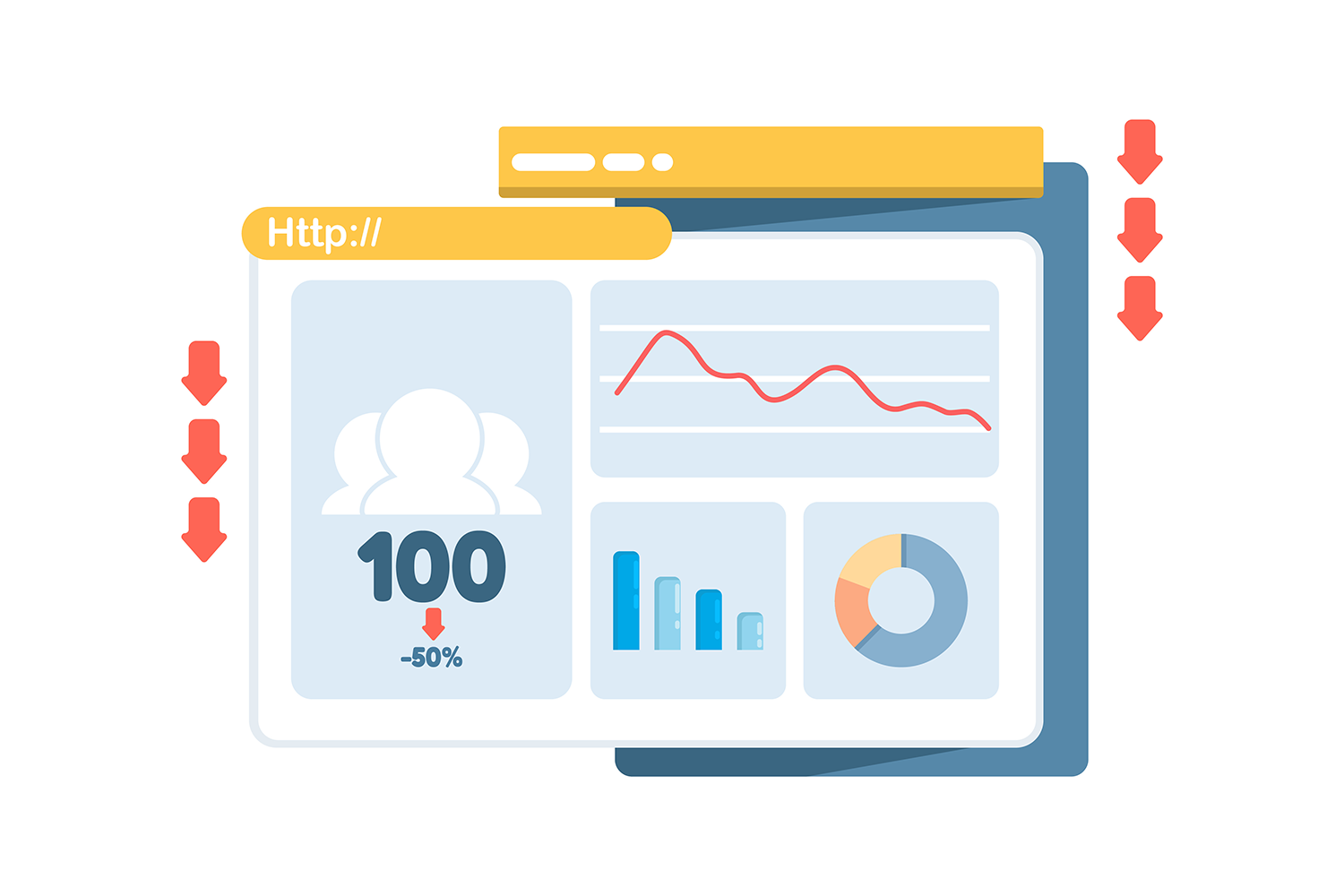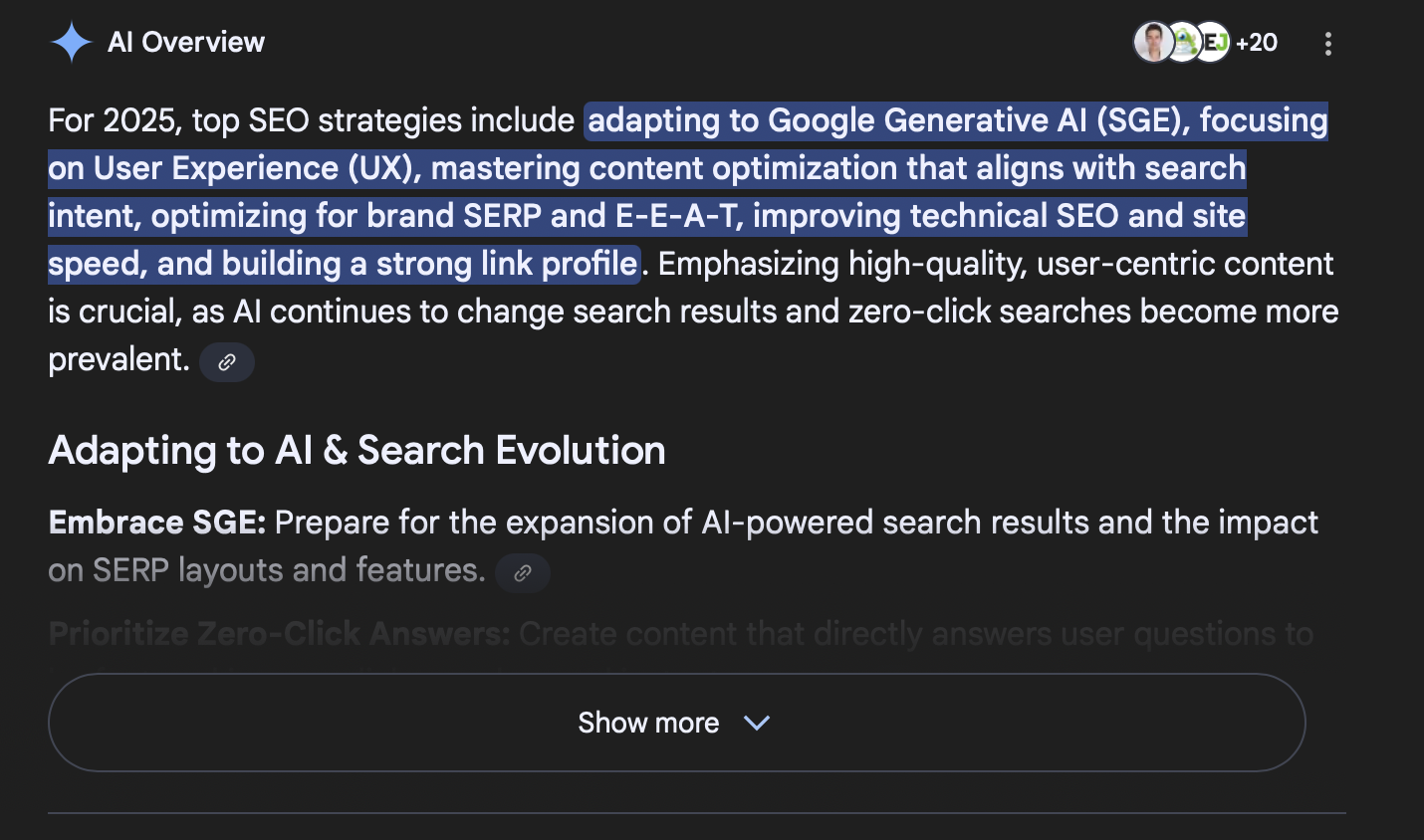
At OlivSEO, we’ve always believed that SEO is about connecting your business with people who need what you offer — not just chasing vanity metrics. And in the past years it was a pretty straightforward process – rank for organic keywords that your potential customers are searching with on Google. But with Google’s rollout of AI Overviews, the ground beneath search has shifted, and user behavior is changing drastically.
The result? Organic impressions or clicks dropping. Many businesses are experiencing this right now, and the culprit is clear: Google’s AI Overviews and the rise of zero-click experiences.
In this article we will dive into how AI is changing how people search for information, how it is impacting website traffic for businesses, and what you can do to dominate your competition and stay on top of the ever-changing world of technology.
What Are AI Overviews?
 If you’re not yet familiar, AI Overviews are the AI-generated text boxes that now appear at the top of Google search results. Instead of seeing the traditional 10 blue links, users often see a synthesized answer pulled from multiple websites.
If you’re not yet familiar, AI Overviews are the AI-generated text boxes that now appear at the top of Google search results. Instead of seeing the traditional 10 blue links, users often see a synthesized answer pulled from multiple websites.
This sounds convenient for users — and it is. They can now see full answers to their question directly in AI overview, without having to click multiple websites and read different articles. Soon, customers will be able to purchase products directly from AI overview, without ever visiting the website.
But for businesses, it creates a new challenge: ranking #1 no longer guarantees a click.
At OlivSEO, we help our clients understand that this isn’t “the end of SEO.” It’s the beginning of SEO 2.0 — where visibility means more than clicks.
Why Clicks Are Dropping (and Why That’s Not All Bad)
Here’s the reality:
- 58–60% of searches now end without a click.
- Pages with AI Overviews lose about 30–35% of clicks. You can learn more about this trend from a recent Ahref study here.
- Informational queries (the ones most blog content is built around) are the most impacted. Read more about this on Search Engine Journal.
On the surface, that sounds alarming. But there’s a silver lining.
When people do click through, they tend to be more qualified and ready to convert. Instead of a casual reader skimming a blog post, you’re getting someone who already did their initial research and is closer to making a decision. That often means a higher conversion rate from fewer visits.
Shifting the SEO Mindset: From Clicks to Visibility

Traditional SEO was built on a simple formula:
Rank well → get traffic → convert.
With AI Overviews and zero-click searches, the new formula is more nuanced:
Be visible → earn trust → convert when ready.
Search engines no longer act as web directories. They are more like advisors, that collect data from various reputable sources, and provide a simple response or answer based on various sources. AI tools attempt to mimic human processes of going through results and finding the best answer.
That means your SEO strategy needs to adapt in three big ways:
- Get cited inside AI Overviews. Google often links out to sources in its AI boxes. Structuring your content so it’s scannable, trustworthy, and authoritative increases your chances of being referenced.
- Build authority beyond Google. AI pulls from multiple platforms: YouTube, Reddit, industry sites, and more. If your brand is present there, you increase your odds of being part of the “answer.”
- Optimize for conversion, not just traffic. Since fewer people will land on your site, every visit matters. Strong calls-to-action, trust signals, and conversion paths are more critical than ever.
How to Optimize for the AI Overview Era
At OlivSEO, we’re helping clients adjust by focusing on structured, trustworthy, and useful content. Here are a few best practices:
- Lead with clear answers. You have to create content that is useful to your audience.
- Keep clear structure. Break content into short sections. Keep a clear hierarchy with heading. Use bullets and tables – those help AI to extract answers accurately.
- Have strong metadata. Search engines parse metadata before they parse body copy. So make sure your meta titles are strong, and keyword-aligned. Keep meta description clear and short.
- Add schema markup. Use Article, FAQ, and HowTo schema so Google’s systems can parse your content effectively. Schema gets AI context about the structure and the purpose of the content that you’re providing.
- Create topical authority. You have to demonstrate that you are a subject matter expert. Also cover topics in clusters that reinforce each other, and keep strong internal linking. Google is able to assess the tone, consistency, and authenticity of the content that you produce. So don’t fabricate your credentials. Be authentic, and transparent about your business practices. Show real bios, references, and subject matter testimonials on your website.
- Refresh old content. Update posts with current data, add author bios, and provide external references.
- Repurpose content. Turn a blog into a YouTube explainer, a LinkedIn carousel, or a short-form video. Search is happening everywhere, not just on Google.
- Use rich media. Visuals and videos help to keep your audience engaged. It also adds topical substance for AI. Rich media can also appear in AI overview.
- Show your brand beyond your website. Stay visible on YouTube, Reddit, TikTok, and other sites where your audience is active. Meet your audience where they are asking questions. If you seed your content on other platforms, AI may pull your content from those sites and you may still be cited in AI overview. But be sure to stay human and authentic. Posting fake comments on forums just to inject your brand name or website will not work, and will most likely get rejected very quickly. So only post practical content.
You can dive deeper into this in our content marketing insights, where we share practical ways to keep your content competitive.
What to Measure When Clicks Drop
If impressions and clicks aren’t the whole story anymore, what should you track? Unfortunately, AI overviews don’t provide click or visibility reporting (at least not yet). So you have to look for indirect signals. Learn to look at your traffic data by diving deeper. Sometimes you may publish a content and not ever know if it was read, because it may just show in AI overview. But still – trust the process. If you are adding quality content, it will work.
- Brand searches. Are more people Googling your company name after seeing you in an overview?
- Assisted conversions. Look at multi-touch attribution reports in analytics. Many users discover you in an AI Overview, then convert later via another channel.
- Share of voice. Track where your brand shows up in answer engines, forums, and PR placements.
Final Thoughts: SEO Isn’t Dead — It’s Different
Google’s CEO called AI Overviews a “permanent evolution in search.” That means they’re not going away. But that doesn’t mean your SEO investment is wasted — it means your approach needs to evolve.
The businesses that win will be the ones who:
- Accept that not every search will drive a click.
- Prioritize being present wherever answers are happening.
- Focus on conversions and brand authority over raw traffic.
At OlivSEO, we help companies thrive in this zero-click world by building strategies designed for visibility, authority, and long-term growth.
If you’re ready to adapt, let’s talk. Start with a free consultation on our Contact page.


Really great read — I appreciate how clearly you explained the importance of local online presence for businesses today. It’s a topic many companies overlook, but it truly makes a difference. I recently came across Lokando24.de, a German business directory that helps local companies get found more easily, and your points align perfectly with what they’re building. Thanks for sharing such valuable insights!